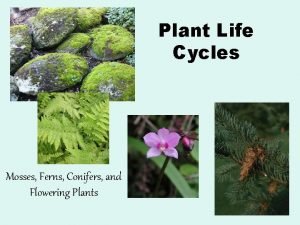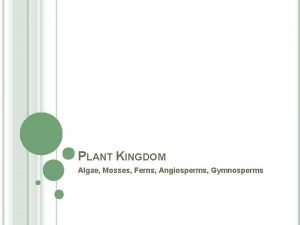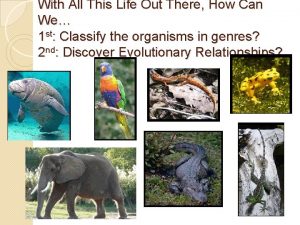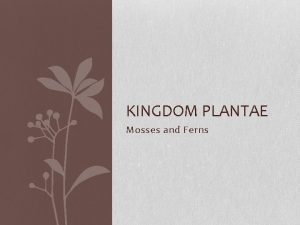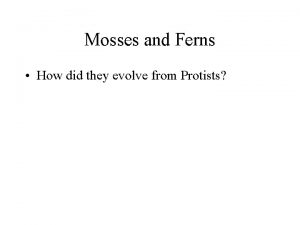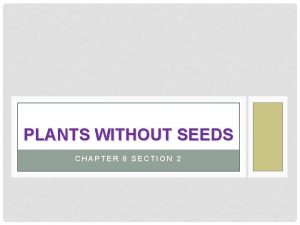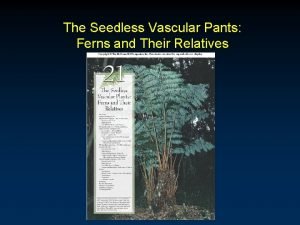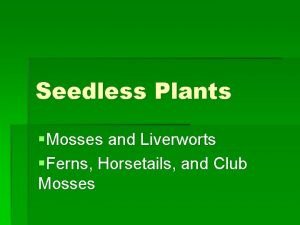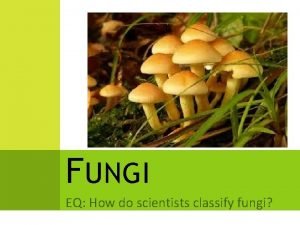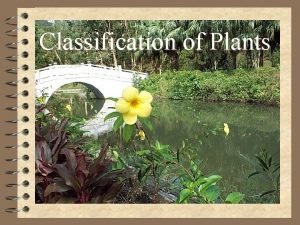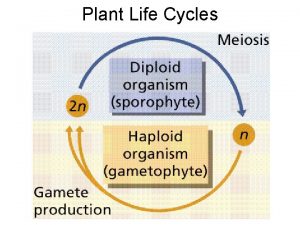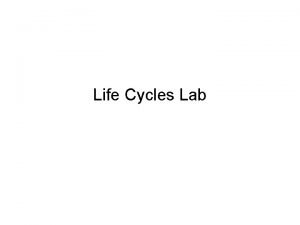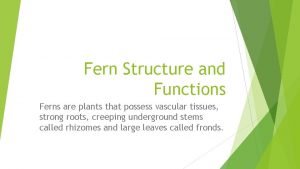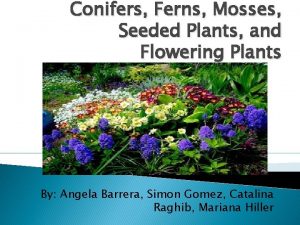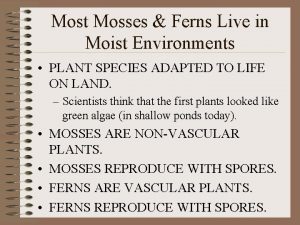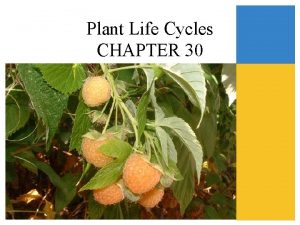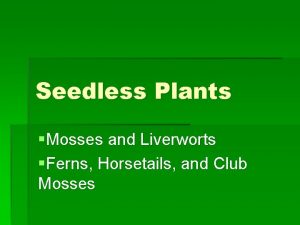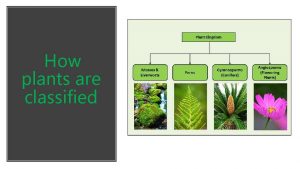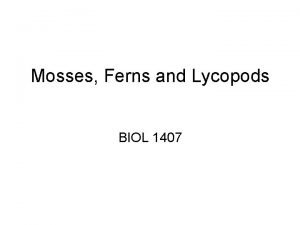Plant Life Cycles Mosses Ferns Conifers and Flowering














- Slides: 14

Plant Life Cycles Mosses, Ferns, Conifers, and Flowering Plants

General Life Cycle of Plants • Recall that all plants cycle between two phases during their life • Called ‘alternation of generations’ • The two generations are gametophytes and sporophytes

Life Cycles of Seed Plants • Seed plants evolved after mosses and ferns • They have efficient vascular systems and seeds to nourish offspring • Gymnosperms = mostly pine trees; use cones for reproduction • Angiosperms = flowering plants; use flowers to attract pollinators

Gymnosperm Life Cycle • In pine trees, the mature tree is the sporophyte (diploid) • The tree makes two cone types: the male pollen cone and female seed cone • Pollen cones make the male gametophyte: pollen

Gymnosperm Life Cycle • The seed cone produces the female gametophyte, which produces thousands of eggs • At the base of each cone scale, there are two ovules where the gametophyte develops • The gametophyte and pollen are haploid Ovules developing gametophytes

Gymnosperm Life Cycle • Wind carries pollen to the female cones, where fertilization occurs • Fertilization creates a young, diploid sporophyte on the cone scale • Once the cone drops, the sporophyte develops into a mature plant

Angiosperm Life Cycle • In flowering plants, the sporophyte is the mature plant we see • The sporophyte produces flowers, complete with anthers and an ovary • Anthers create pollen, the male gametophyte

Angiosperm Life Cycle • The female gametophyte develops in the ovule (eggs) of the flower • Pollen lands on the stigma, travels down the style, and fertilizes the ovule • The fertilized egg is now diploid, and is packaged into a seed • The seed is surrounded by a fleshy ovary called ‘fruit’

Angiosperm Life Cycle • When the fruit falls to the ground, the seed can grow into a seedling, a new, diploid sporophyte

Fruit Development • Once fertilization occurs, flower petals die off and nutrients are rushed to the seed • Parts of the ovule toughen to form a seed coat • The ovary containing the ovules forms a tough skin and swells with sugary tissue • Fruit = a seed enclosed in an ovary

Types of Fruit • Simple fruit = development of large ovary from one pistil • Aggregate fruit = development of small ovaries from multiple pistils on one flower • Multiple fruit = development of ovaries from many flowers that fuse together to form one mass

Aggregate Fruits Simple Fruits Multiple Fruits

What’s a Bulb? • A bulb is NOT a fruit or seed • A bulb is an entire plant, resting dormant underground • Bulbs contain precursors to root, shoot, and leaf systems that will mature when conditions are right • Perennial monocots typically utilize bulbs

Life Cycles Review! • Complete the Coloring Activity for Gymnosperm and Angiosperms • As a class, we will go outside and collect one piece of evidence of each life cycle (moss, fern, gymnosperm, angiosperm) • Inside, you will identify the pieces of evidence and explain all four life cycles to a partner
 Is conifer a flowering plant
Is conifer a flowering plant Mosses ferns gymnosperms angiosperms
Mosses ferns gymnosperms angiosperms Cladogram of mosses pine trees flowering plants ferns
Cladogram of mosses pine trees flowering plants ferns Characteristics of ferns and mosses
Characteristics of ferns and mosses Mosses and ferns
Mosses and ferns Chapter 8
Chapter 8 Phylum psilotophyta
Phylum psilotophyta Liverworts seedless
Liverworts seedless Flowering plants and non flowering plants similarities
Flowering plants and non flowering plants similarities Flowering and non flowering plants
Flowering and non flowering plants Characteristics of non flowering plants
Characteristics of non flowering plants Plant life cycles and alternation of generations
Plant life cycles and alternation of generations Haploid and diploid numbers
Haploid and diploid numbers Functions of parts of the leaf
Functions of parts of the leaf Function of fronds in ferns
Function of fronds in ferns
